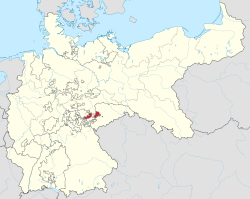Saxe-Altenburg
Saxe-Altenburg (German: Sachsen-Altenburg) was one of the Ernestine duchies of the House of Wettin.[1] Altenburg was independent for most of the 1600s until 1672. This is when the last male ruler died. Because only men could rule the Ernestine duchies Altenburg began to be ruled by the Duke of Saxe-Gotha, who had married the last ruler’s daughter.
Duchy of Saxe-Altenburg Herzogtum Sachsen-Altenburg | |||||||||
|---|---|---|---|---|---|---|---|---|---|
| 1602 – 1672 1672 – 1825* 1826 – 1918 1918 – 1920† | |||||||||
| Anthem: Heil unserm Herzog, heil (Hail to our Duke, hail!) | |||||||||
 Saxe-Altenburg within the German Empire  Ernestine duchies after 1825, showing Saxe-Altenburg in orange | |||||||||
| Status | State of the Holy Roman Empire, State of the German Confederation, State of the North German Confederation, State of the German Empire, State of the Weimar Republic | ||||||||
| Capital | Altenburg | ||||||||
| Government | Principality | ||||||||
| Duke | |||||||||
• 1603 – 13 | Christian II, Elector of Saxony (regent for John Philip) | ||||||||
• 1669 – 72 | John George II, Elector of Saxony (regent for Frederick William III) | ||||||||
• 1826 – 34 | Frederick | ||||||||
• 1908 – 18 | Ernst II | ||||||||
| History | |||||||||
• Saxe-Weimar partitioned | July 7, 1602 1602 | ||||||||
| 1672 – 1825 | |||||||||
• Ernestine duchies rearranged, duchy restored | November 12, 1826 | ||||||||
• German Revolution | November 1918 1918 | ||||||||
• Merger of Thuringia‡ | 1920 | ||||||||
| Area | |||||||||
| 1905 | 1,323 km2 (511 sq mi) | ||||||||
| Population | |||||||||
• 1905 | 207000 | ||||||||
| |||||||||
* See Saxe-Gotha-Altenburg † As Free State of Saxe-Altenburg ‡ In 1920, the ex-Imperial states of Saxe-Altenburg, Saxe-Meiningen, Saxe-Coburg-Gotha, Saxe-Weimar-Eisenach, Schwarzburg-Sondershausen, Schwarzburg-Rudolstadt and the two principalities of Reuß all merged to form the free state of Thuringia. | |||||||||

In 1825 the ruler died, and he also had no male heirs. Saxe-Gotha-Altenburg was split up. Gotha was given to the Duke of Saxe-Coburg-Saalfeld and Altenburg to the Duke of Saxe-Hildburghausen, who in exchange gave up Saalfeld and Hildburghausen to the Duke of Saxe-Meiningen. This family ruled in the duchy until the end of the monarchies in 1918. Saxe-Altenburg became part of the new state of Thuringia in the Weimar Republic in 1920.
Saxe-Altenburg had an area of 1,323 km2 (510.8 sq mi) and a population of 207,000 (1905). Its capital was Altenburg.
The Saxe-Altenburg line became extinct following the death of Prince George Moritz in 1991.
Dukes of Saxe-Altenburg
change- Frederick, Duke of Saxe-Altenburg (1826-1834) (Previously Duke of Saxe-Hildburghausen)
- Joseph, Duke of Saxe-Altenburg (1834-1848)
- Georg, Duke of Saxe-Altenburg (1848-1853)
- Ernst I, Duke of Saxe-Altenburg (1853-1908)
- Ernst II, Duke of Saxe-Altenburg (1908-1918)
Heads of the Ducal House of Saxe-Altenburg, post monarchy
change- Ernst II, Duke of Saxe-Altenburg (1918-1955)
- Georg Moritz, Hereditary Prince of Saxe-Altenburg (1955-1991)
In 1991 the Saxe-Altenburg line became extinct.
Two branches descend from duke Ernest the Pious, the father of the progenitor of this Saxe-Altenburg branch: Saxe-Meiningen and Saxe-Coburg-Gotha; according to old Wettin family law, they would have divided the actual territories between them (as happened to Gotha and Altenburg in 1826). The senior male agnate descending from duke Ernest the Pious, in 1991 , was prince Frederick-Alfred of Saxe-Meiningen (a monk, 1921-1997), and thus technically succeeded then as titular duke of Saxe-Altenburg and head of the whole branch; but, because he renounced all his succession rights in favor of his uncle Bernhard, was him instead Frederick-Alfred the general heir of the line of Saxe-Meiningen. His successor was Konrad, Duke of Saxe-Meiningen, the present head of that branch.
Related pages
changeReferences
change- ↑ "The Ernestine Line's Saxon Duchies" (Web). Historical Atlas. Tacitus Historical Atlas. Retrieved 2007-05-19.
Other websites
change

